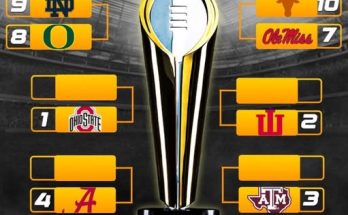All eyes are now fixated on Texas Tech, and for good reason. After years of quietly rebuilding its athletic department, football infrastructure, and overall recruiting culture, the Red Raiders have exploded into the national spotlight by surpassing the $20 million roster budget mark—an achievement that not even the mighty Ohio State could boast last season. In a sport increasingly dominated by the economics of Name, Image, and Likeness (NIL), this seismic financial statement signals a radical shift in college football’s power dynamics. It’s no longer just Alabama, Georgia, and Ohio State dictating terms. Now, Texas Tech has planted a flag—loudly, boldly, and with a blank check in hand.
Ohio State’s $20 million budget last season was widely viewed as the ceiling for NIL investment at the highest level of the sport. That figure encompassed endorsement deals, collective-driven contracts, and donor-backed financial strategies to retain and attract top-tier talent. It set a benchmark—until Texas Tech stepped in and rewrote the rules. Boosted by a reinvigorated fan base, deep-pocketed alumni, and an administration unafraid to embrace the chaotic winds of the NIL era, the Red Raiders have leveraged every possible resource to tip the scales in their favor. Their message is unmistakable: Lubbock isn’t a stepping stone anymore—it’s a destination.
While critics will debate whether this is a sustainable model or a short-term adrenaline shot, the early results suggest Texas Tech knows exactly what it’s doing. Recruiting is already reflecting the shift. The Red Raiders have landed commitments from several top-100 prospects, including players who in previous years might not have even taken official visits to West Texas. In a sport where perception is reality, suddenly Texas Tech isn’t the scrappy underdog anymore. They’re the disruptor. And perhaps most impressively, they’re doing it in a way that feels organic, not gimmicky. There’s a football-first culture being cultivated in Lubbock that’s finally backed by a war chest powerful enough to compete with the best.
The comparison to Ohio State is telling. While the Buckeyes are a perennial top-five team with a century of football tradition behind them, they’ve also become a lightning rod in the NIL discussion—sometimes portrayed as overly corporate, sometimes as cautious spenders relative to other powerhouses. Texas Tech, on the other hand, has embraced the free-market chaos of modern college football with open arms and Texan swagger. Their boosters and collectives have made it clear: if talent acquisition is now transactional, then they are prepared to win that transaction every time. And they’re not just spending to spend—they’re strategically targeting positions of need, rewarding player retention, and emphasizing development. In short, they’re building a roster, not just a brand.
Head coach Joey McGuire, a high-energy leader with deep Texas high school coaching roots, has become the perfect figurehead for this movement. Charismatic, aggressive, and unapologetically competitive, McGuire has turned Texas Tech into a player-centric program where money, mentorship, and opportunity intersect. His alignment with the university’s NIL vision is crystal clear. This isn’t about buying a championship overnight—it’s about creating a sustainable, professionalized ecosystem where elite athletes feel valued, seen, and supported. In a world where player empowerment matters more than ever, Texas Tech is speaking the language fluently.
This shift doesn’t come without pressure. When you spend over $20 million on a roster, expectations rise just as steeply. Texas Tech is no longer allowed to surprise people—they’re now expected to win. A middling season or a lackluster bowl appearance would be scrutinized far more heavily than before. There’s also the ever-present risk of locker room imbalance or public backlash if the NIL money isn’t distributed with transparency and fairness. But for now, the momentum is real. And while other programs scramble to catch up or recalibrate their own NIL operations, Texas Tech is already a step ahead.
There’s a cultural undertone to all of this too. The state of Texas has always been fertile recruiting ground, and the Red Raiders are now poised to build a wall around West Texas and beyond. No longer do elite players from Amarillo, Midland, or Lubbock feel they need to escape to Austin, Norman, or College Station to play big-time football. The bright lights, the big checks, and the big games are now available right at home. More than just a monetary shift, it’s a cultural reclamation—and it’s resonating deeply with recruits and families alike.
The implications stretch far beyond Texas Tech’s locker room. This could be the tipping point that forces the NCAA, Power Five commissioners, or even Congress to take a more active role in regulating or standardizing NIL practices. The lack of a salary cap, the decentralized nature of NIL collectives, and the uneven playing field are all now more visible than ever. With Texas Tech leapfrogging a blueblood like Ohio State in roster value, the sport finds itself on the brink of a reckoning. Do we applaud innovation, or do we call for reform? The answer likely depends on whether your team is ahead of the curve or struggling to keep up.



